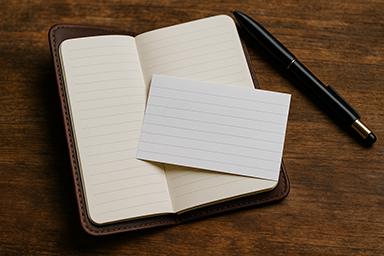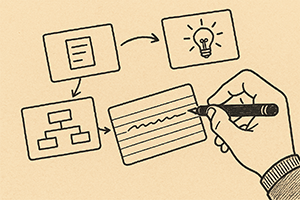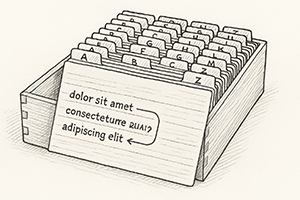The Analog Inbox: Capturing Ideas by Hand

We’ve moved fast: digital notes, synced devices, voice memos. But what if the best way to catch a spark of an idea still begins with pen on paper? Let’s rewind to a simpler time—and to something smarter.
Why the Analog Inbox Matters
The Slip‑Box method (aka Zettelkasten) is built on a time-tested foundation of fleeting, literature, and permanent notes—and it all starts with an analog inbox.
Capture your fleeting thoughts—half-formed, spontaneous, urgent—on index cards or a pocket notebook whenever they hit. Then, in your processing ritual, convert them into long-lasting ideas.
Neuroscience tells us: handwriting activates memory and creativity in ways typing doesn't. It's deliberate, it's meaningful—and it forces you to process information deeply. That's clarity hidden in plain sight.
The Slip‑Box Workflow Simplified
- Fleeting Notes: Jot down an idea or reference as soon as it appears—on whatever's on hand.
- Literature Notes: When doing structured reading (articles, books, lectures), capture salient points in your own words—just a sentence or two per card.
- Permanent Notes: Later, rewrite cards into atomic, self-contained cards—each with a unique ID and links to related cards.
- Link & Tag: Create connections. Don’t file hierarchically—let ideas form a web.
- Review & Process: Regularly transfer cards from your inbox to the slip‑box—daily or weekly.
Tools of the Analog Trade
- A pocket notebook or stash of 3×5 or 4×6 index cards
- A dependable pen (some prefer black ink + a red highlighter for linking)
- A sturdy slip‑box to keep cards upright, organized, and visible

The Ritual of Processing
Here’s where the magic happens: your weekly inbox-to-slipbox ritual.
- Lay out your stack of cards.
- For each:
- If it's a fleeting idea, decide whether to discard, develop into a literature note, or wrap it into a permanent note.
- If it's a literature note, rewrite it: clarify, add context, isolate one idea per card.
- Add a unique ID and link it to relevant cards already in your slip‑box—creating that interconnected web.
This ritual is not a chore—it’s your analog second brain taking shape.

The Payoff: An Emergent Knowledge System
The analog inbox isn't nostalgia—it's strategy. Over time, your slip‑box becomes:
- A creative springboard: new insights surface from linking old ideas.
- A second brain: you don't rely on memory—you rely on your system.
- A flexible archive: tag by theme or use Luhmann’s numbering scheme for bottom‑up organization.

Give It a Real-World Try
- Carry 5–10 index cards and a pen.
- Write as thoughts come—don’t judge.
- Once a week, process your cards.
- Revisit and link them into your slip‑box.
If you're after unfiltered creativity, reflection, and flow, you’ll find what you're looking for in these simple analog rituals.
